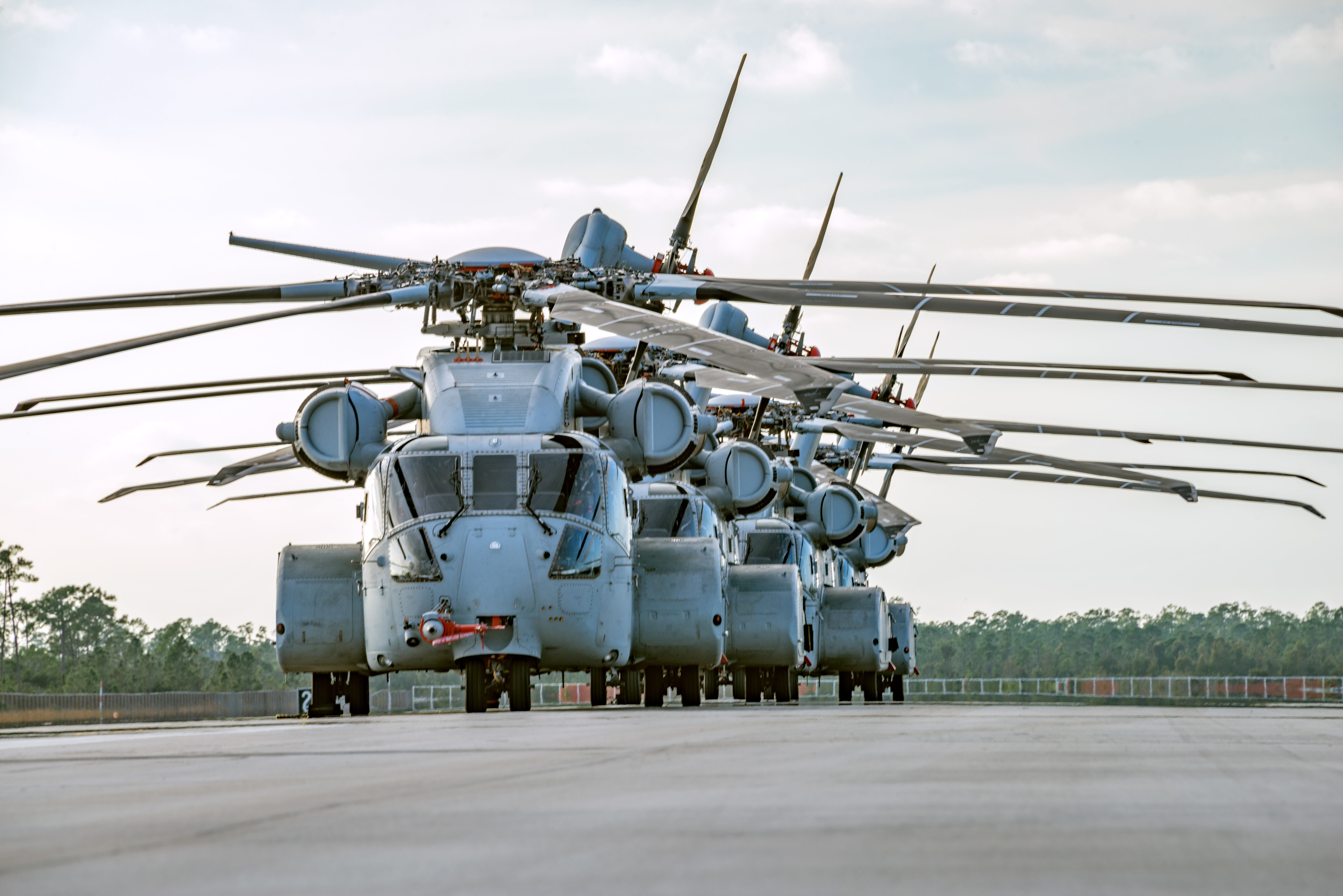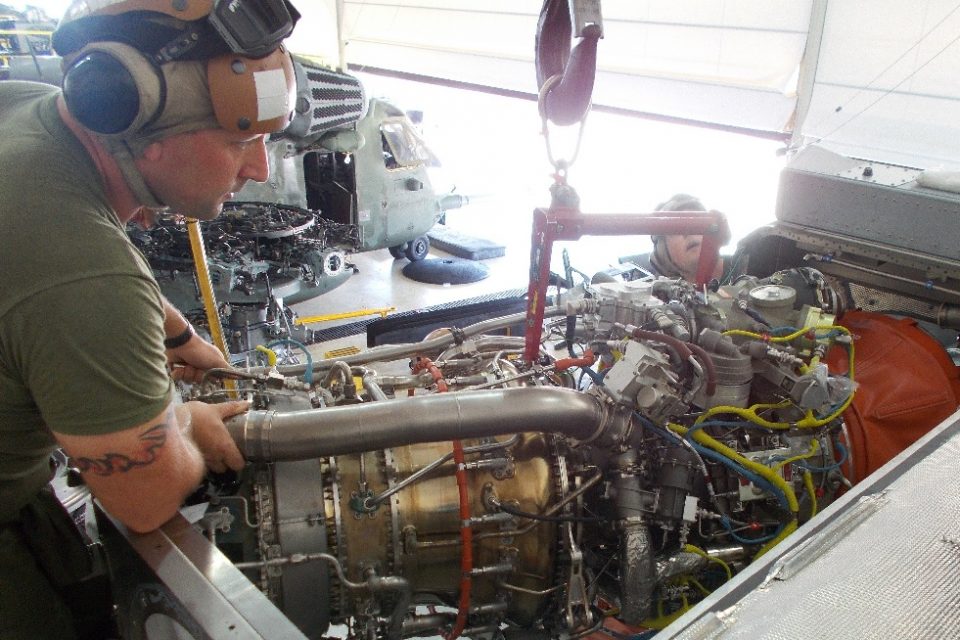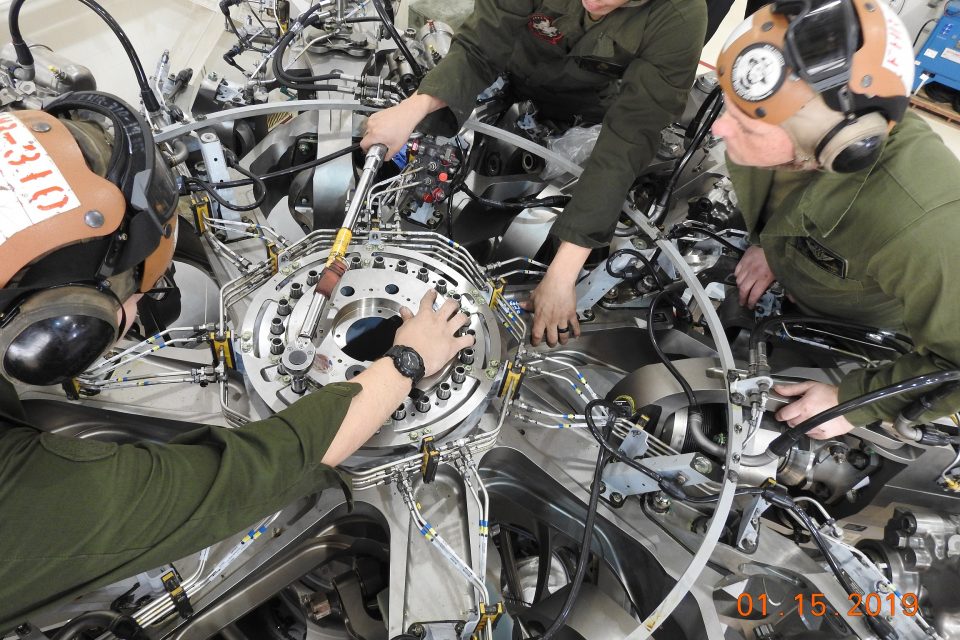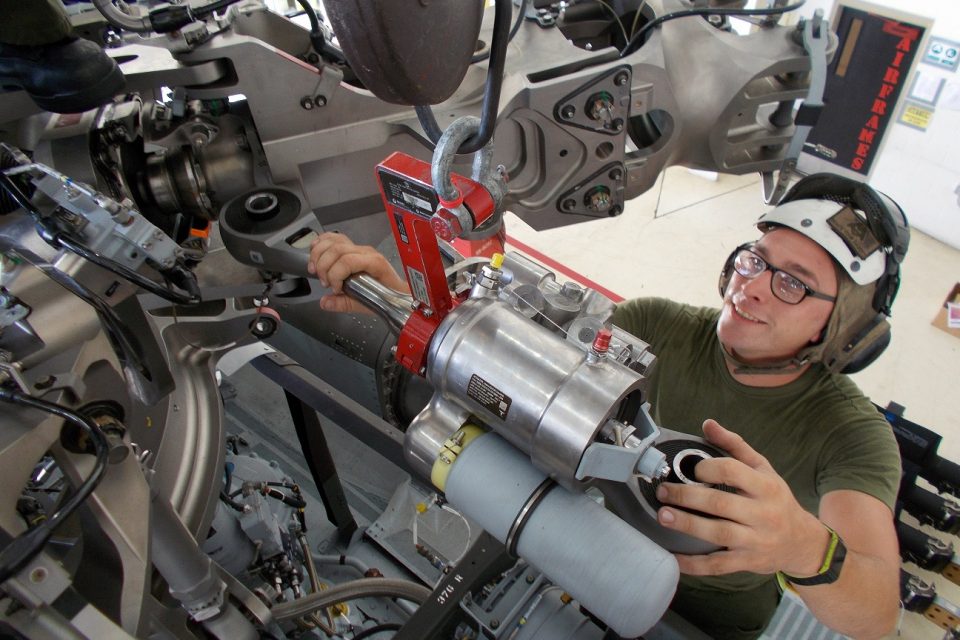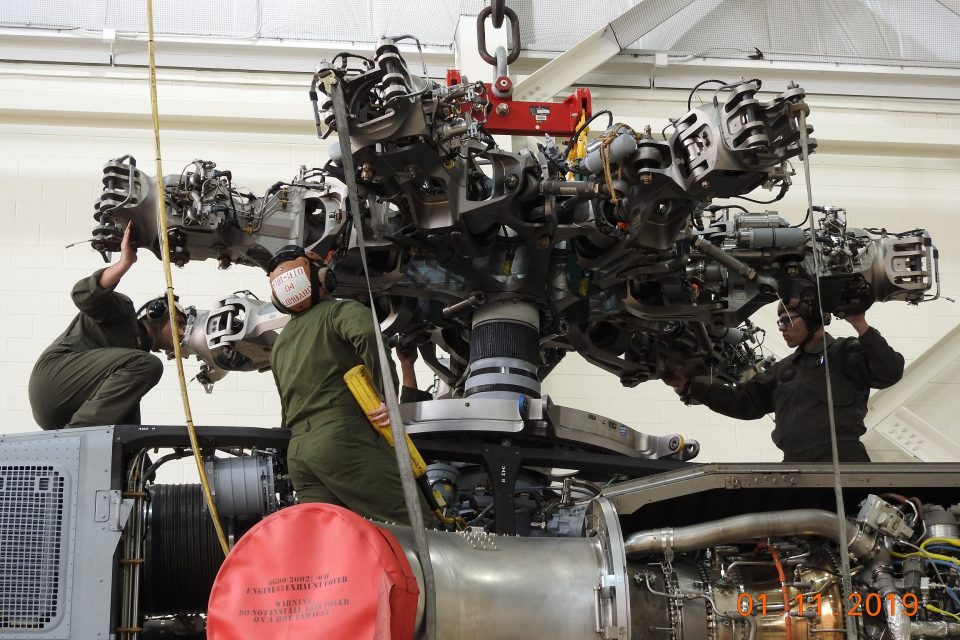By Robbin Laird
Recently, I visited New River to talk with the team doing the Log Demo in support of the CH-53K.
A decade ago I visited the Osprey maintainers standing up the Osprey at New River as well.
I have republished a number of those interviews from a decade ago with the maintainers to provide a baseline against which to measure the progress for the USMC as they standup their next major ground support air system.
I reached back to one of my hosts during the Log Demo visit, Jim Lambert, the head field representative for Sikorsky working on the Log Demo, to discuss the differences between the two generations of aircraft from a maintenance perspective as well as to discuss some aspects of the generational change in heavy lift from the CH-53E to the CH-53K.
Question: How would contrast the standup of the K with that of the Osprey from a maintenance perspective?
Lambert: We are directly focused on the training of the Marine maintainers in a crawl, walk and run approach.
“We are building the confidence of the Marine maintainers as well as building the domain technical knowledge.
“We are taking the time to teach them not just how to maintain the aircraft but confidence on the aircraft.
“They are getting a rare opportunity to get incredibly valuable touch time in a slow paced learning environment, which allows them to get comfortable with the airplane.
“Clearly, when we get to flight, operations we are going to ask them to run, but only after a smooth learning curve leading up to them confidently maintaining the aircraft.
“We’ve put the tools designed to maintain the aircraft into their hands to test in the environment they were designed for ahead of the time that we’re going actually have them use them for the first time.
“And with their feedback, we can ensure they meet all the needs of the fleet to support aircraft operations. We collect the data and have the ability to adjust the tools designs as needed.
“Much like the aircraft itself that was designed in an office and is being tested in its intended designed environment, we are doing the same with all the aspect of fleet supportability and logistics.
“The maintenance procedures, tooling, ground support equipment, spares, data collection and maintenance tracking systems are being tested now in their intended environment by the target users.
“Testing the entire scope during log demo has added opportunity to train and familiarize the Marines through the full spectrum of what fleet support will be.”
Question: And to be clear, with the Osprey, the Marines started by walking their way through the first manuals to support operations.
Aren’t you with the logs demo shaping domain knowledge rather than manuals to launch the K fleet experience?
Lambert: That is correct.
“We are focused on having the Marines working with the airplane get familiar and comfortable with the maintenance approach and indeed, to shape that approach.
“In Osprey interviews which you published from a decade ago, one of the challenges highlighted was the lack of knowledge, the lack of being comfortable with the airplane which led to a high amount of premature removal of parts for unknown failures.
“We are focused on training the Marines to make good sound judgment calls when troubleshooting and performing maintenance.”
Question: How does having a Sikorsky field rep involved in the team affect the learning continuity process?
Lambert: Continuity of experience and the learning curve to be built by such experience is a key part of the program.
“As the aircraft proliferates across the globe to USMC operating bases, we will have service reps deployed with the aircraft.
“We are going to be there to shape the domain knowledge and confidence factor crucial to maintenance, especially with regard to a digital aircraft.
“We will provide a backstop for the Marines who can be confident that we are providing representation, boots on the ground, wherever the aircraft’s going to be operating.”
Question: My final question is to turn to one aspect of the difference between the legacy CH-53 and the new one.
When I was at New River recently, you have an E next to a K and you were doing rotor head maintenance on the K and had just removed the rotor blades. How do you do that differently on the two aircraft and to do so in a way that gives the K much greater capability to support a higher ops tempo?
Lambert: The 53K is a completely different airplane than the 53E, so there is virtually no place on the K that I can’t walk around and show you that there’s been a head and shoulders improvement over the legacy 53E.
“There’s so much thought that went into the maintainability of this aircraft.
“We’ve removed a significant amount of parts on the airplane compared to the legacy CH-53.
“This was possible by moving from a mechanical aircraft to a digital 21stcentury aircraft.”
“We removed whole gear boxes from the airplane, dozens of mechanical flight control components with multiple bit piece parts, engine cables and a significant amount of analog avionics and hydraulic components.
“All these required spare part support, repair capability, recurring maintenance inspection as well as significant amounts of time to manually rig/ adjust these systems.
“We’ve simplified it mechanically, like no other aircraft that I’ve ever worked on or have had experience with.
“A prime example of maintainability influenced aircraft design is the rotor system”
“You asked about the rotors and blades which provide a good example of simplification and greater robustness.
“We’re using an elastomeric rotor head system.
“We didn’t use an elastomeric rotor on our 53E; we used what’s called a Wet Head which is a rotor head which uses oil bath bearings and spherical bearings for all control points as opposed to elastomeric bearings, which are rubber composite bearings.
“We don’t use any spherical bearings on the rotor head itself on the K.
“Spherical bearings have a lot higher wear rate, and they have a lot higher inspection intervals. The spherical bearings wear out at a significant rate compared to an elastomeric bearing.
“We’ve proven elastomeric bearings, out through many years of use, on the 60 fleet to 92s. They’re very good, reliable bearings. We have at least a few hundred flight hours on most of the 53K aircraft in test by now with almost all still flying with all their original bearings installed.
“In comparison, the 53E, the spherical bearings are inspected and they’re changed on a pretty routine basis every 25 to 50 hours.
“This means that using the elastomeric bearings significantly reduces the maintenance burden as far as inspection and actual time on maintenance is concerned.”
“With regard to the blades, maintenance has simplified and sped up as well.
“The blades are held, on a 53E rotor head, with a bolts and all require safety cable. This process includes applications of primer, bolts to be installed, torque sequences to perform and safety cable application ending with sealant.
“There’s a rotor blade servicing procedure that we have to do as part of the old in flight blade inspection system.
“In contrast, for the 53K, the plane has a fully composite rotor blade with no service needed. Two quick release pins hold it on and even the grounding wire is a quick release.
“We can put these blades on and off in a very short amount of time. It’s very much of an improved interface as far as maintenance is concerned.
“These are some of the key maintenance improvements along with blade removal and reinstallation, servicing the rotor head, the dampers on the rotor head can all be individually serviced as need. They are not all serviced together as is required by the 53E. The result is a better more maintainable rotor head.”
“Clearly, the less time we’re performing excessive inspections or maintenance due to the before mentioned significant reductions in parts, modularized design with an aircraft built for unparalleled maintainability; the more time we’re able to fly and complete the mission.”
“Bringing people home everywhere every time! “
Editor’s Note:
What one saw through the early years of the Osprey was a clear problem with lack of understanding of parts failures and lack of confidence or familiarity of Marine maintainers with the certain key parts performance which led to a more hit and miss approach to manage the parts flow.
This point was driven home to me in an interview with Col. Seymour prior to his retirement from the USMC, a senior Marine who knew the Osprey better than anyone.
In the exit interview I did with Colonel Christopher ‘Mongo’ Seymour in the summer of 2013 during the week prior to his retirement, the hard hitting and well-respected Marine Corps leader provided a look back and a way ahead with regard to sustainment of the Osprey.
QUESTION: A major challenge in fielding a new system is getting the supply chain up and working and getting the inevitably maintenance problems sorted out.
How have you worked through these problems?
Col. Seymour: There are three separate streams of activity which need to align to really get the new system up and running and integrated into operations.
The first is getting the Marines committed to owning the system and learning how to fix “new” problems, which come up with a new system.
The problems are different and have to be worked differently.
You need to get the maintainers to change their culture.
Sorting out problems with the gearbox is a good example of what needed to be done.
The gearbox on this airplane is very complex and central to its unique operational capabilities.
The gearbox inside the nacelle turns a rotor, and they were chipping.
This is high-end engineering.
But it was chipping and when it did so maintainers put it aside and waited for a new part.
This meant the fleet was going to be degraded.
The flight line needed to take ownership of the problem because a lot of it was self-inflicted gunshot wounds.
Maintainers would look to blame someone else when they had a Prop Rotor gearbox go bad.
As it turns out, the technology required was to use isotropic oil that actually absorbs moisture out of the air, so if you have a gearbox that’s not turning and boiling the oil out on a regular basis, it goes long term down.
It’s sucking in the moisture of the North Carolina Coast into the oil.
And the maintainers would leave it out on the flight line all opened up just breathing the air, and then when they finally got a part or piece, they try to fire it up and another gearbox would chip or another problem would manifest itself someplace else. It was an endless loop.
We took some ownership here on flight line, and shaped better maintenance practices, and to help industry.
Once we got that Prop Rotor gearbox moving back out of the red into the black, the internal culture of the community changed to become significantly more optimistic, you know.
The maintenance man-hours required to change a proper gearbox initially was estimated at 1800 maintenance man-hours.
We’re doing it now in about 380.
That’s how good we got at it.


